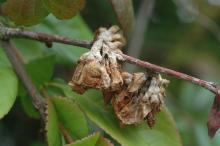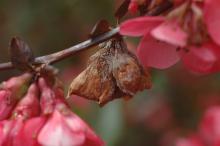See:
Cherry (Prunus spp.) - Brown Rot Blossom Blight and Fruit Rot
Quince (Cydonia oblonga) - Fire Blight
Cause Several fungal species of Monilinia can incite a blossom blight, a twig and branch dieback, and a fruit rot of several different hosts. Pome fruit, including quince, can be susceptible under high disease pressure years. Fungi survive year to year on infected twigs, branches, old flower parts, or mummified fruit. Conidia are produced on infected plant debris in the tree when the temperature is above 40°F. A small, mushroom-like structure (apothecium) can be produced on fruit that drops to the ground. Wind and rain blow spores (conidia and ascospores) to healthy blossoms in spring to begin the infection process during wet weather. Infection does not occur below 50°F and will occur for M. laxa above 55°F. Flowers can be blighted any time floral tissue is exposed but are most susceptible at full bloom. More spores can be produced on this tissue, initiating several more disease cycles during the spring.
Symptoms Infected flower parts turn light brown and may develop areas of buff-color or gray spores. Infected petals may look water soaked, which can be mistaken for frost injury. Flowers generally collapse as the fungus invades through the pedicel. Infected flowers often adhere to twigs and spurs through harvest or even winter. The early symptoms of brown rot blossom blight on quince could be mistaken for fire blight.
Cultural control These must be supplemented by chemical methods especially in the wettest areas such as west of the Cascade Range.
- Remove and destroy infected twigs and branches in summer.
- Shorten large trees and prune out shaded limbs in summer for a more open canopy that dries out quickly.
- Remove and destroy all mummified fruit in and around the tree. Cultivating or burying old fruit before the growing season will not reduce the risk of this disease. However, removing fallen fruit (due to thinning or lack of pollination) can significantly reduce the amount of rot at harvest.
- Avoid wounding fruit during harvest.
- Cool fruit rapidly after harvest.
- Use moderate amounts of nitrogen fertilizer.
Chemical control Many of the chemicals used for leaf spot management will also have activity on brown rot.



